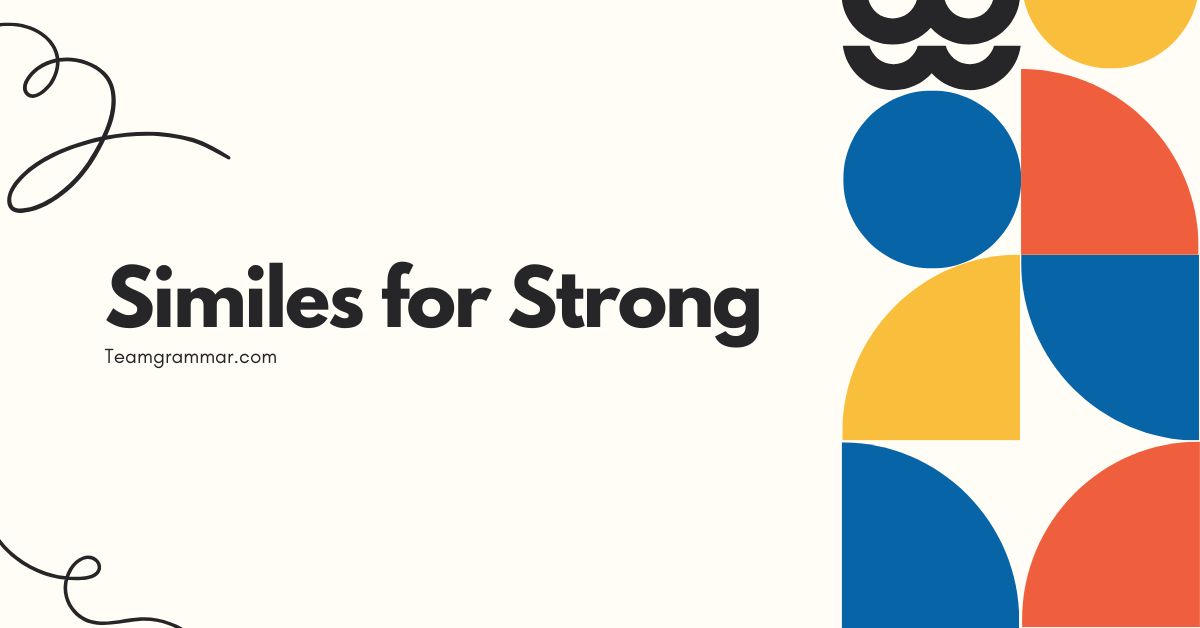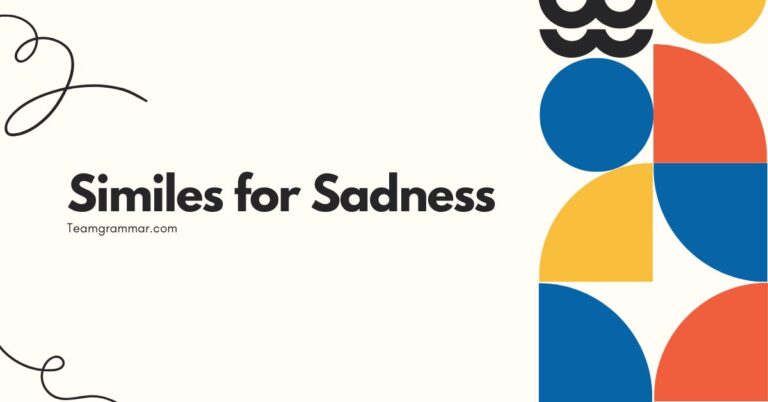31 Similes for Strong: Mastering Figurative Language
Understanding similes is crucial for enriching your writing and enhancing comprehension of literary texts. Similes, a type of figurative language, allow us to create vivid comparisons and paint compelling pictures with words.
This article explores the use of similes to describe strength, providing a comprehensive guide for students, writers, and anyone looking to improve their English language skills. By delving into various examples and practical exercises, you’ll learn how to effectively use similes to convey the concept of “strong” in a more imaginative and impactful way.
This guide will benefit learners of all levels, from beginners seeking to grasp the basics of figurative language to advanced speakers aiming to refine their stylistic choices. The structured approach, complete with definitions, examples, and practice exercises, will empower you to confidently incorporate similes into your everyday communication and creative writing.
Table of Contents
- Definition of Simile
- Structural Breakdown of Similes
- Types of Similes for Strong
- Examples of Similes for Strong
- Usage Rules for Similes
- Common Mistakes with Similes
- Practice Exercises
- Advanced Topics in Similes
- Frequently Asked Questions
- Conclusion
Definition of Simile
A simile is a figure of speech that directly compares two different things using the words “like” or “as.” The main purpose of a simile is to enhance the description by associating the qualities of one thing with another, creating a more vivid and relatable image or understanding. Similes are an essential tool in writing, allowing authors to add depth and nuance to their work.
Similes belong to the broader category offigurative language, which includes metaphors, personification, and hyperbole. Unlike metaphors, which state that something *is* something else, similes only suggest similarity.
This distinction is crucial for understanding and using similes correctly. They function to clarify, emphasize, or create a specific tone or mood.
In essence, a simile acts as a bridge, connecting two seemingly unrelated concepts to illuminate a shared characteristic. Consider the example: “He is as strong as an ox.” This simile doesn’t claim heisan ox, but rather that his strength is comparable to that of an ox, known for its powerful build and endurance.
This comparison provides a more impactful and easily understood sense of his strength.
Structural Breakdown of Similes
The structure of a simile is relatively straightforward, typically consisting of three key elements: the subject being described, the linking word (“like” or “as”), and the object of comparison. Understanding this structure is essential for constructing effective and grammatically correct similes.
The basic formula is: Subject + Linking Word + Object of Comparison.
Let’s break this down further:
- Subject: This is the person, place, thing, or idea being described. For example, in the simile “Her voice was like velvet,” the subject is “Her voice.”
- Linking Word: This is the word that establishes the comparison. The two most common linking words are “like” and “as.” Using the correct linking word is critical to forming a simile.
- Object of Comparison: This is the person, place, thing, or idea to which the subject is being compared. In the example “He is as brave as a lion,” the object of comparison is “a lion.”
The order of these elements can sometimes be varied for stylistic effect, but the core components and their relationship remain the same. For example, instead of saying “She was as quiet as a mouse,” you could say “As quiet as a mouse, she entered the room.” However, the latter structure is less common and should be used judiciously.
It’s also important to ensure that the comparison is logical and meaningful. A simile should draw a connection that is both clear and relevant to the context.
A poorly constructed simile can be confusing or even nonsensical.
Types of Similes for Strong
When using similes to describe strength, it’s helpful to categorize them based on the type of strength being conveyed. This allows for more precise and impactful descriptions.
Here are some common categories:
Physical Strength
These similes focus on the physical power and robustness of a person or object. They often invoke images of strong animals, natural forces, or sturdy structures.
Emotional Strength
Emotional strength similes highlight resilience, courage, and the ability to withstand emotional hardship. These often involve comparisons to enduring natural elements or steadfast objects.
Mental Strength
Mental strength similes describe intellectual fortitude, determination, and the ability to overcome mental challenges. They often involve comparisons to sharp tools, unwavering focus, or strategic thinkers.
Strength of Objects
These similes describe the durability and resilience of inanimate objects. They often compare objects to strong materials, imposing structures, or forces of nature.
Examples of Similes for Strong
The following sections provide extensive examples of similes used to describe different types of strength. Each section includes a table with a variety of similes, demonstrating the breadth and versatility of this figurative language technique.
Physical Strength
These similes are used to describe raw physical power, often comparing the subject to strong animals or natural forces. The goal is to create a sense of immense physical capability.
The table below illustrates common similes used to describe physical strength.
| Simile | Explanation |
|---|---|
| As strong as an ox | Compares the subject’s strength to the immense power of an ox, known for its ability to pull heavy loads. |
| As strong as a bull | Similar to “as strong as an ox,” this simile highlights raw, aggressive power. |
| As strong as a bear | Implies a combination of power and ferocity. |
| As strong as Hercules | Refers to the legendary hero known for his superhuman strength. |
| As strong as a lion | Suggests both physical power and courage. |
| As strong as steel | Compares the subject’s strength to the unyielding nature of steel. |
| As strong as iron | Similar to “as strong as steel,” emphasizing durability and resilience. |
| As strong as a rock | Highlights the subject’s unwavering and solid nature. |
| As strong as an elephant | Emphasizes immense size and power. |
| As strong as a gorilla | Implies brute strength and dominance. |
| As strong as a bodybuilder | Directly refers to someone who cultivates extreme physical strength. |
| As strong as a weightlifter | Similar to “as strong as a bodybuilder,” emphasizing lifting capabilities. |
| As strong as a wrestler | Implies a combination of strength, agility, and technique. |
| As strong as a tree | Suggests resilience, rootedness, and the ability to withstand storms. |
| As strong as a hurricane | Emphasizes destructive power and overwhelming force. |
| As strong as a tidal wave | Similar to “as strong as a hurricane,” highlighting an unstoppable force. |
| As strong as a fortress | Implies impregnability and unyielding defense. |
| As strong as an engine | Suggests mechanical power and efficiency. |
| As strong as a machine | Similar to “as strong as an engine,” emphasizing relentless power. |
| As strong as an oak | Like “as strong as a tree”, emphasizing resilience and long lasting strength |
| As strong as a giant | Highlights immense size and power |
| As strong as a tank | Implies invincibility and the ability to withstand damage. |
| As strong as gravity | Emphasizes an irresistible and constant force. |
| As strong as a dam | Highlights the ability to hold back immense pressure. |
Emotional Strength
Emotional strength is the capacity to cope with stress, trauma, and adversity. These similes often compare the subject to things that are resilient, enduring, or unwavering.
The table below provides examples of similes that capture the essence of emotional strength.
| Simile | Explanation |
|---|---|
| As strong as an oak | Suggests resilience and the ability to withstand storms. |
| As strong as a mountain | Implies unwavering stability and endurance. |
| As strong as a rock | Highlights steadfastness and an unyielding spirit. |
| As strong as a fortress | Suggests an ability to defend against emotional attacks. |
| As strong as a lighthouse | Implies providing guidance and stability in turbulent times. |
| As strong as a mother’s love | Emphasizes unwavering devotion and protection. |
| As strong as a father’s resolve | Highlights determination and the ability to make tough decisions. |
| As strong as hope | Implies an indomitable spirit that perseveres through hardship. |
| As strong as faith | Suggests unwavering belief and trust in something greater. |
| As strong as a survivor | Directly refers to someone who has overcome significant adversity. |
| As strong as a shield | Implies protection from emotional harm. |
| As strong as a wall | Suggests an impenetrable barrier against negativity. |
| As strong as a deep-rooted tree | Emphasizes stability and resilience through generations. |
| As strong as the human spirit | Highlights the inherent capacity for resilience and perseverance. |
| As strong as forgiveness | Implies the power to overcome resentment and heal emotional wounds. |
| As strong as resilience | Highlights the inherent ability to bounce back. |
| As strong as courage | Implies bravery and the ability to face fear. |
| As strong as determination | Suggests unwavering commitment to a goal. |
| As strong as integrity | Emphasizes moral strength and uprightness. |
| As strong as self-belief | Highlights confidence and trust in one’s abilities. |
| As strong as steel will | Suggests unwavering resolve and determination. |
| As strong as a warrior | Implies mental and emotional fortitude in tough situations. |
| As strong as a sunflower | Highlights the ability to turn towards the light even in dark times. |
| As strong as an anchor | Implies stability and security in turbulent seas. |
| As strong as the tide | Suggests relentless and unstoppable emotional force. |
Mental Strength
Mental strength involves cognitive resilience, focus, and the ability to overcome intellectual challenges. These similes often draw comparisons to sharp tools, strategic thinkers, or unwavering focus.
The following table provides examples of similes that illustrate mental strength.
| Simile | Explanation |
|---|---|
| As sharp as a tack | Implies quick wit and keen intelligence. |
| As sharp as a razor | Suggests incisive thinking and the ability to cut through complexity. |
| As focused as a laser beam | Highlights intense concentration and unwavering attention. |
| As strategic as a chess player | Suggests the ability to think ahead and plan effectively. |
| As determined as a marathon runner | Emphasizes perseverance and the ability to endure mental challenges. |
| As resilient as a rubber band | Implies the ability to bounce back from setbacks. |
| As disciplined as a monk | Suggests unwavering self-control and focus. |
| As analytical as a scientist | Highlights the ability to observe, analyze, and draw conclusions. |
| As logical as a computer | Implies rational thinking and the ability to solve problems systematically. |
| As wise as an owl | Suggests deep understanding and insightful judgment. |
| As strong as a memory | Highlights the ability to recall and retain information. |
| As strong as conviction | Suggests unwavering belief and commitment to one’s principles. |
| As strong as will power | Implies the ability to resist temptation and achieve goals. |
| As strong as creativity | Highlights the ability to generate new ideas and solutions. |
| As strong as a conviction | Emphasizes a firm and unwavering belief. |
| As strong as a mathematician | Suggests logical prowess and problem-solving skills. |
| As strong as a scholar | Implies deep knowledge and intellectual curiosity. |
| As strong as a detective | Highlights investigative skills and the ability to uncover hidden truths. |
| As strong as a CEO | Suggests strong decision-making and leadership abilities. |
| As strong as a startup founder | Implies resilience, innovation and strong vision. |
| As strong as a coder | Highlights problem solving skills and logical thinking. |
| As strong as an astronaut | Suggests mental fortitude and ability to work under pressure. |
| As strong as a surgeon | Implies precision, focus and ability to make difficult decisions. |
| As strong as an engineer | Highlights problem solving skills and analytical thinking. |
| As strong as a philosopher | Suggests critical thinking and deep understanding. |
Strength of Objects
These similes describe the durability and resilience of inanimate objects, often comparing them to strong materials, imposing structures, or forces of nature.
The table below presents examples of similes used to describe the strength of objects.
| Simile | Explanation |
|---|---|
| As strong as steel | Compares the object’s strength to the unyielding nature of steel. |
| As strong as iron | Similar to “as strong as steel,” emphasizing durability and resilience. |
| As strong as concrete | Highlights the object’s solid and unyielding nature. |
| As strong as a diamond | Implies exceptional hardness and resistance to damage. |
| As strong as a bridge | Suggests the ability to withstand heavy loads and connect disparate points. |
| As strong as a skyscraper | Highlights the object’s imposing size and structural integrity. |
| As strong as a dam | Implies the ability to hold back immense pressure and control powerful forces. |
| As strong as a vault | Suggests impregnability and protection against intrusion. |
| As strong as a cable | Highlights the object’s ability to withstand tension and support heavy loads. |
| As strong as a chain | Similar to “as strong as a cable,” emphasizing interconnectedness and strength. |
| As strong as a foundation | Suggests stability and the ability to support a large structure. |
| As strong as a pillar | Highlights the object’s ability to provide support and stability. |
| As strong as a fortress wall | Implies impregnability and defense against attack. |
| As strong as a safe | Suggests protection against theft and damage. |
| As strong as a lock | Highlights the object’s ability to secure and protect. |
| As strong as a shield | Implies protection from physical harm. |
| As strong as a helmet | Suggests protection for the head and brain. |
| As strong as armor | Highlights comprehensive protection against attack. |
| As strong as a battering ram | Implies the ability to break through barriers and overcome resistance. |
| As strong as a tank | Suggests invincibility and the ability to withstand damage. |
| As strong as a submarine | Highlights the ability to withstand immense pressure underwater. |
| As strong as a rocket | Implies the ability to generate immense thrust and escape gravity. |
| As strong as a spacecraft | Suggests the ability to withstand extreme temperatures and radiation. |
| As strong as graphene | Highlights the exceptional strength and lightweight nature of this material. |
| As strong as Kevlar | Suggests resistance to bullets and other projectiles. |
Usage Rules for Similes
Using similes effectively requires adherence to certain rules and guidelines. While similes offer creative freedom, understanding these rules ensures clarity and impact.
- Use “like” or “as”: The most fundamental rule is to use either “like” or “as” to establish the comparison. Without these words, the statement becomes a metaphor.
- Ensure Logical Comparison: The comparison should be logical and make sense. The qualities being compared should be relevant and easily understood.
- Avoid Clichés: Overused similes, such as “as strong as an ox” (while valid), can lack impact. Strive for originality to make your writing more engaging.
- Consider Context: The simile should be appropriate for the context in which it is used. A simile that is effective in one situation may be inappropriate in another.
- Maintain Clarity: The simile should enhance understanding, not obscure it. Avoid overly complex or obscure comparisons.
It’s also important to consider the tone and style of your writing. Similes can be used in both formal and informal contexts, but the specific simile chosen should be appropriate for the overall tone.
For example, in a formal academic paper, you might use a simile like “The theory is as robust as a well-supported bridge,” while in a more informal setting, you might say “He’s as strong as a bull.”
Common Mistakes with Similes
Even experienced writers can make mistakes when using similes. Recognizing these common errors can help you avoid them and improve the quality of your writing.
Here are some frequent mistakes to watch out for:
- Confusing Similes with Metaphors: This is perhaps the most common mistake. Remember that similes use “like” or “as” to make a comparison, while metaphors state that something *is* something else.
- Using Illogical Comparisons: The comparison should be clear and relevant. Avoid comparing things that have little or nothing in common.
- Overusing Clichés: While clichés can be effective in certain situations, overuse can make your writing seem unoriginal and uninspired.
- Creating Mixed Metaphors/Similes: Mixing metaphors or similes creates a confusing and often nonsensical image. For example, saying “He’s as strong as an ox, but he’s also a sitting duck” creates a contradictory image.
Here are some examples of correct vs. incorrect usage:
| Incorrect | Correct | Explanation |
|---|---|---|
| He is an ox. | He is as strong as an ox. | The first sentence is a metaphor, while the second is a simile. |
| She is as strong as a cloud. | She is as strong as a rock. | The first simile is illogical, while the second is logical. |
| He’s as strong as an ox, but he’s also a feather in the wind. | He’s as strong as an ox. OR He’s as light as a feather in the wind. | The first sentence mixes similes, creating a contradictory image. The second two sentences are grammatically sound and do not clash with each other. |
| The building is like tall. | The building is as tall as a skyscraper. | The first sentence is grammatically incorrect. The second sentence is a well-formed simile. |
Practice Exercises
These exercises will help you practice using similes to describe strength. Each exercise focuses on different aspects of simile construction and usage.
Exercise 1: Identifying Similes
Identify the similes in the following sentences.
| Question | Answer |
|---|---|
| 1. His resolve was as strong as steel. | as strong as steel |
| 2. She is a rock in times of trouble. | (None – this is a metaphor) |
| 3. The building stood as strong as a fortress. | as strong as a fortress |
| 4. His grip was like iron. | like iron |
| 5. The argument was as solid as concrete. | as solid as concrete |
| 6. Her spirit shone as bright as the sun. | as bright as the sun |
| 7. The team worked together like a well-oiled machine. | like a well-oiled machine |
| 8. He was as brave as a lion in the face of danger. | as brave as a lion |
| 9. The athlete’s muscles were as strong as ropes. | as strong as ropes |
| 10. His words cut like a knife. | like a knife |
Exercise 2: Completing Similes
Complete the following similes with an appropriate comparison.
| Question | Answer |
|---|---|
| 1. He was as strong as ______. | an ox |
| 2. Her will was like ______. | iron |
| 3. The foundation was as solid as ______. | rock |
| 4. His determination was as unwavering as ______. | a mountain |
| 5. The structure was as sturdy as ______. | a bridge |
| 6. She stood as tall as ______. | a skyscraper |
| 7. His loyalty was as deep as ______. | the ocean |
| 8. The team worked as one, like ______. | a hive of bees |
| 9. Her gaze was as piercing as ______. | a laser |
| 10. The code was as secure as ______. | a vault |
Exercise 3: Writing Similes
Write a simile to describe the following types of strength.
| Prompt | Example Answer |
|---|---|
| 1. Physical strength | He was as strong as a bear, able to lift incredible weights. |
| 2. Emotional strength | Her emotional strength was like a sturdy oak, weathering every storm. |
| 3. Mental strength | His mental strength was as sharp as a razor, cutting through complex problems. |
| 4. Strength of an object | The bridge’s strength was like steel, capable of handling heavy traffic. |
| 5. Describe a mother’s or father’s strength | A mother’s love is as strong as an unbreakable bond, protecting her children. |
| 6. Describe the strength of forgiveness | Forgiveness is as strong as medicine, healing deep wounds. |
| 7. Describe the strength of hope | Hope is as strong as a lighthouse, guiding sailors through the storm. |
| 8. Describe the strength of determination | Determination is as strong as a climber’s grip, pulling them up the mountain. |
| 9. Describe the strength of conviction | His conviction was as strong as a rock, unshaken by doubt. |
| 10. Describe the strength of will power | Willpower is as strong as a dam, holding back impulsive desires. |
Advanced Topics in Similes
For advanced learners, exploring more nuanced aspects of similes can further enhance their writing skills. This includes understanding the use of extended similes and the interplay between similes and other figures of speech.
Anextended simileis a simile that is developed over several lines or even an entire paragraph. This allows for a more detailed and complex comparison, creating a richer and more vivid image for the reader.
For example:
“Her strength was like a mighty river, constantly flowing, carving its path through the toughest terrain, overcoming obstacles with relentless force, and nourishing everything in its wake.”
Similes can also be combined with other figures of speech to create even more powerful effects. For example, a simile can be combined with personification to give human qualities to an object being compared:
“The mountain stood as strong as a sentinel, guarding the valley below with its unwavering gaze.”
Understanding these advanced techniques can help you use similes in more sophisticated and creative ways, adding depth and nuance to your writing.
Frequently Asked Questions
Here are some frequently asked questions about similes.
- What is the difference between a simile and a metaphor?
A simile compares two things using “like” or “as,” while a metaphor states that one thing *is* another. Similes suggest similarity, while metaphors imply equivalence.
- Why are similes important in writing?
Similes enhance descriptions, create vivid images, and make writing more engaging and relatable. They allow writers to convey complex ideas in a more accessible way.
- How can I avoid using clichés when writing similes?
Strive for originality by thinking creatively and exploring less common comparisons. Consider the specific qualities you want to emphasize and find unique ways to express them.
- Can a simile be too complex?
Yes, a simile should be clear and easy to understand. Avoid overly complex or obscure comparisons that may confuse the reader.
- Is it okay to use similes in formal writing?
Yes, similes can be used in formal writing, but the specific simile chosen should be appropriate for the overall tone and style of the piece.
- How do I choose the right object of comparison for a simile?
Choose an object of comparison that shares relevant qualities with the subject being described. The comparison should be logical and meaningful.
- What if I can’t think of a good simile?
Don’t force it. Sometimes it’s better to use a more direct description than a poorly constructed simile. You can also try brainstorming different comparisons and seeing what feels right.
- Are there any types of writing where similes are not appropriate?
While similes can be used in many types of writing, they may not be appropriate in highly technical or scientific contexts where precise, literal language is required.
- Can I use similes in everyday conversation?
Absolutely! Similes can add color and expressiveness to your everyday conversations. Just be mindful of your audience and the context.
- How do I know if a simile is effective?
An effective simile will enhance understanding, create a vivid image, and make your writing more engaging. If the simile feels forced or confusing, it’s probably not working.
- What are some other figures of speech that are similar to similes?
Metaphors, personification, hyperbole, and analogies are all related figures of speech that can be used to enhance writing and create vivid imagery. Similes and metaphors are often closely related, but similes use “like” or “as” for comparison, while metaphors directly state that something *is* something else.
Conclusion
Mastering the art of using similes to describe strength can significantly enhance your writing and communication skills. By understanding the definition, structure, and usage rules of similes, you can effectively convey the concept of “strong” in a more imaginative and impactful way.
Remember to avoid clichés, ensure logical comparisons, and consider the context in which you are writing.
Practice is key to developing your ability to craft compelling similes. Experiment with different comparisons, explore various types of strength, and pay attention to how professional writers use similes in their work.
With consistent effort, you’ll be able to confidently incorporate similes into your writing and everyday communication, adding depth, nuance, and creativity to your language.







